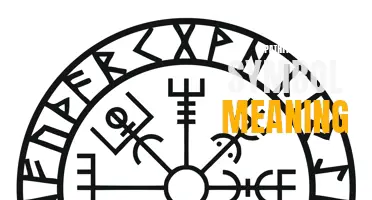
Thermostats play a crucial role in maintaining a comfortable environment within our homes, but if you've ever looked closely at a thermostat, you may have found yourself puzzled by the array of symbols displayed. These symbols are not just random images; they hold important meanings that help users understand and utilize their thermostat's functions effectively. In this article, we will uncover the mysteries behind these thermostat symbols and empower you to take control of your home's temperature with confidence. So, buckle up and join us on this journey to decode the symbols of your thermostat!
What You'll Learn
- What are some common symbols found on thermostats, and what do they represent?
- How can understanding thermostat symbols help improve energy efficiency in the home?
- Are there any international or industry-specific variations in thermostat symbols and their meanings?
- Is there a standard set of symbols for thermostat settings, or do they vary between different brands and models?
- What resources are available for homeowners to learn more about thermostat symbols and their meanings?

What are some common symbols found on thermostats, and what do they represent?
A thermostat is a device used to control the temperature of a heating or cooling system in a building. It helps maintain a comfortable environment by monitoring the ambient temperature and activating the appropriate heating or cooling system as needed. Thermostats often feature various symbols that represent different functions and settings. Understanding these symbols is essential for using the thermostat effectively. In this article, we will explore some common symbols found on thermostats and what they represent.
- Power symbol - The power symbol represents whether the thermostat is receiving electrical power or not. It is usually depicted as a simple circle or a stylized "P." When the power symbol is displayed, it means the thermostat is properly connected to a power source and is functioning correctly.
- Flame symbol - The flame symbol is commonly found on thermostats that control heating systems. It represents the heating mode of the thermostat and indicates that the heating system is activated. The flame symbol is usually shown as a stylized fire icon or a simple geometric shape resembling a flame.
- Snowflake symbol - The snowflake symbol is often used on thermostats that control cooling systems. It represents the cooling mode of the thermostat and indicates that the cooling system is activated. The snowflake symbol is typically depicted as a small snowflake or a simple geometric shape resembling a snowflake.
- Up and down arrows - The up and down arrows represent the temperature adjustment feature of the thermostat. The up arrow is usually used to increase the set temperature by one degree, while the down arrow is used to decrease the set temperature. These arrows are often labeled with their respective functions or may be used without any text.
- Clock symbol - Some thermostats feature a clock symbol, indicating that they have a built-in clock or scheduling function. The clock symbol represents the ability to program the thermostat to automatically adjust the temperature based on a set schedule. This feature is especially useful for maintaining energy efficiency and comfort throughout the day.
- Temperature scale - Thermostats often display a temperature scale that indicates the selected temperature setting or the current ambient temperature. The scale may be depicted using numbers, which represent temperature in Fahrenheit or Celsius, or using a simple graphic that shows warmer and cooler temperature levels.
- Mode symbols - Thermostats may include additional mode symbols to indicate various operating modes or settings. For example, a sun symbol may represent a sunny or bright mode, while a moon symbol may represent a nighttime or sleep mode. These symbols can vary depending on the specific thermostat model and its functionalities.
It is essential to consult the thermostat's user manual or manufacturer's instructions for detailed information about the symbols and their meanings specific to your thermostat model. However, understanding these common symbols will provide a good starting point for effectively using and navigating your thermostat's settings.
Understanding the Symbols and Meanings on Yamaha Tach Gauges
You may want to see also

How can understanding thermostat symbols help improve energy efficiency in the home?
Understanding thermostat symbols can greatly help improve energy efficiency in the home. A thermostat is a device used to control the temperature in a room or building, and understanding the symbols on the thermostat can help homeowners make informed decisions about how to adjust the temperature to save energy.
One important symbol on a thermostat is the heat symbol, which usually looks like a flame. This symbol indicates that the thermostat is set to heat mode, meaning it will turn on the heating system to warm up the room. By understanding this symbol, homeowners can accurately set the thermostat to a comfortable temperature without wasting unnecessary energy.
Another important symbol is the cool symbol, which usually looks like a snowflake. This symbol indicates that the thermostat is set to cool mode, meaning it will turn on the air conditioning system to cool down the room. By understanding this symbol, homeowners can set the thermostat to a cooler temperature during hot summer months without overcooling the room and wasting energy.
Some thermostats also have additional symbols that indicate different features and settings. For example, there may be a symbol for fan mode, which indicates that the thermostat will only activate the fan without turning on the heating or cooling system. This can be useful for circulating air in the room without changing the temperature.
Understanding these symbols and their meanings can also help homeowners take advantage of energy-saving features on their thermostats. Many thermostats have a programmable mode, which allows users to set different temperature levels at different times of the day. By understanding the symbols associated with this feature, homeowners can program the thermostat to lower the temperature during times when they are away from home, saving energy and reducing utility costs.
Furthermore, some thermostats have symbols for vacation mode or hold mode. These symbols indicate that the thermostat will maintain a specific temperature for an extended period of time, such as when the homeowners are on vacation. By understanding these symbols, homeowners can avoid unnecessary energy consumption while they are away.
It is also important to understand symbols related to temperature adjustment. Many thermostats have symbols for increasing or decreasing the temperature, allowing users to fine-tune the temperature settings to their comfort level without wasting energy.
In conclusion, understanding thermostat symbols can greatly improve energy efficiency in the home. By knowing what each symbol represents, homeowners can make informed decisions about how to adjust the temperature and take advantage of energy-saving features on their thermostats. This can lead to lower energy consumption, reduced utility costs, and a more comfortable living environment. So take the time to familiarize yourself with the symbols on your thermostat and start saving energy today.
The Symbolic Meaning Behind Flickering Lights and What It Signifies
You may want to see also

Are there any international or industry-specific variations in thermostat symbols and their meanings?
When it comes to thermostat symbols and their meanings, there can be some variations. These variations may be due to international differences or industry-specific standards. Let's explore these variations further.
International Variations:
Different countries may have their own standards and symbols for thermostat controls. For example, the United States uses a variety of symbols to indicate different functions on thermostats. These symbols include a snowflake for cooling, a flame for heating, and a sun for auto mode. In contrast, European countries often use symbols like a radiator for heating and a fan for cooling.
Additionally, temperature measurement units can vary worldwide. The United States commonly uses Fahrenheit, while most other countries use Celsius. This can lead to different symbols or markings on thermostats to indicate temperature settings.
Industry-specific Variations:
Certain industries may have specific standards or requirements for thermostat symbols. For example, in the HVAC (heating, ventilation, and air conditioning) industry, there are industry-standard symbols to represent different functions. These symbols are designed to be easily understood by professionals in the field.
The American Society of Heating, Refrigerating and Air-Conditioning Engineers (ASHRAE) provides a set of symbols used in HVAC designs and documentation. These symbols can differ from the standard symbols found on consumer-grade thermostats.
Furthermore, within the HVAC industry, there may be additional symbols or indicators specific to certain types of equipment. For example, heat pump thermostats may use a specific symbol to indicate the defrost mode or auxiliary heat operation.
There can be variations in thermostat symbols and their meanings based on international differences and industry-specific standards. It's important to refer to the user manual or documentation provided with your thermostat to understand the specific symbols and their meanings. If you work in a specific industry, such as HVAC, there may be additional symbols or indicators that are relevant to your field. Understanding these symbols is crucial for proper operation and control of your thermostat.
Decoding Kubota Tractor Dashboard Symbols: Understanding their Meanings
You may want to see also

Is there a standard set of symbols for thermostat settings, or do they vary between different brands and models?
When it comes to thermostat settings, there isn't a standard set of symbols that applies universally to all brands and models. While there are some common symbols that you may encounter across different thermostats, the specific symbols and markings can vary between brands and models.
Thermostats are designed to control the heating and cooling of your home or workplace. They allow you to set the desired temperature and adjust various settings to achieve optimal comfort. These settings are typically represented by symbols or icons on the thermostat display.
Some of the commonly used symbols on thermostats include:
- "Heat" and "Cool" icons: These symbols indicate whether the thermostat is set to heat or cool mode. The "Heat" icon usually looks like a flame, while the "Cool" icon often resembles a snowflake. These icons may be accompanied by other indicators, such as the letters "H" and "C" for heat and cool, respectively.
- Temperature indicators: Thermostats typically display the current temperature and allow you to set the desired temperature. The current temperature is typically shown either numerically or with a thermometer symbol. The desired temperature can be adjusted using buttons or a dial, and may be represented by an arrow pointing to the desired temperature.
- Fan settings: Many thermostats allow you to control the fan operation. Common symbols for the fan settings may include "Auto," "On," or "Fan." "Auto" means that the fan will only run when heating or cooling is needed, while "On" means that the fan will run continuously.
- Programmable settings: Some thermostats come with programmable features that allow you to set different temperature profiles for different times of the day or week. The symbols for these settings may vary, but often include icons like a clock or calendar.
It's important to note that these symbols are not standardized across all thermostats. Different brands and models may use slightly different symbols or variations of the ones mentioned above. Therefore, it's crucial to refer to the user manual or manufacturer's instructions for your specific thermostat to understand its unique symbols and settings.
If you're unsure about the symbols on your thermostat, it's always a good idea to consult the user manual or reach out to the manufacturer for assistance. They will be able to provide you with the most accurate information regarding the symbols and settings specific to your thermostat.
In conclusion, while there are some common symbols for thermostat settings, there isn't a standard set that applies universally to all brands and models. The symbols and markings can vary between different thermostats, so it's important to refer to the user manual or consult the manufacturer for accurate information about your specific thermostat's symbols and settings.
Decoding the Symbols: Exploring Chrysler Crossfire Dashboard Symbols and Their Meanings
You may want to see also

What resources are available for homeowners to learn more about thermostat symbols and their meanings?
As a homeowner, understanding the symbols and meanings displayed on your thermostat is important for effectively controlling and regulating your home's heating and cooling systems. Familiarizing yourself with these symbols can help you efficiently manage your home's temperature and save energy. Thankfully, there are several resources available to homeowners to learn more about thermostat symbols and their meanings.
- User Manuals: One of the first resources you should consult is the user manual that came with your thermostat. This manual provides detailed information about the symbols and their corresponding meanings specific to your thermostat model. It typically includes diagrams and explanations to help you navigate through the various functions and settings.
- Online Resources: The internet is a treasure trove of information, and there are numerous websites dedicated to educating homeowners about thermostat symbols and their meanings. Many thermostat manufacturers have their own websites that offer comprehensive guides and FAQs sections to assist users with understanding the symbols. Additionally, there are forums and online communities where homeowners share their experiences and knowledge about thermostats, including decoding symbols.
- YouTube Videos and Tutorials: If you prefer visual learning, YouTube can be a valuable resource for understanding thermostat symbols. Many knowledgeable individuals and HVAC professionals upload videos that walk you through the different symbols and explain their meanings. These videos often provide step-by-step instructions on how to interpret and operate your thermostat properly.
- HVAC Professionals: When in doubt, it is always a good idea to consult with a professional HVAC technician. They have the expertise and knowledge to explain the symbols on your thermostat and guide you on how to use them effectively. They can also provide recommendations on the best settings for optimizing energy efficiency and comfort in your home.
- Manufacturer Support: If you have trouble understanding the symbols on your thermostat or need further clarification, reach out to the manufacturer's support team. They can provide assistance via phone, email, or online chat. They may even be able to offer more specific information related to your model or provide additional resources to help you.
Remember, understanding the symbols and meanings on your thermostat is crucial for maintaining a comfortable and energy-efficient home. Utilize the resources available to you, such as user manuals, online guides, videos, professionals, and manufacturer support, to gain a thorough understanding of your thermostat's symbols and how to use them effectively. By doing so, you can take control of your home's heating and cooling systems and make informed decisions to save energy and reduce costs.
Decoding the Hidden Meanings of No Symbol Pokémon Cards
You may want to see also
Frequently asked questions
The snowflake symbol on your thermostat typically indicates the "cool" or air conditioning mode. When this symbol is displayed, it means that your thermostat is set to cool the air in your home or space, providing a comfortable temperature during warmer weather.
The flame symbol on your thermostat usually represents the "heat" mode. This symbol indicates that your thermostat is set to heat the air in your home or space, providing warmth during colder weather. When the flame symbol is displayed, your thermostat is working to maintain the desired temperature for heating.
The fan symbol on your thermostat typically represents the "fan" mode. This symbol indicates that your thermostat is set to circulate air throughout your home or space without providing cooling or heating. When the fan symbol is displayed, the fan will run continuously to help distribute air and maintain air flow.
The battery symbol on your thermostat indicates the battery status of your thermostat. When this symbol is displayed, it means that the batteries in your thermostat need to be replaced or recharged. It is important to address this symbol promptly to ensure that your thermostat continues to function properly and accurately.







